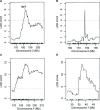An ultra-high density bin-map for rapid QTL mapping for tassel and ear architecture in a large F₂ maize population
- PMID: 24898122
- PMCID: PMC4059873
- DOI: 10.1186/1471-2164-15-433
An ultra-high density bin-map for rapid QTL mapping for tassel and ear architecture in a large F₂ maize population
Abstract
Background: Understanding genetic control of tassel and ear architecture in maize (Zea mays L. ssp. mays) is important due to their relationship with grain yield. High resolution QTL mapping is critical for understanding the underlying molecular basis of phenotypic variation. Advanced populations, such as recombinant inbred lines, have been broadly adopted for QTL mapping; however, construction of large advanced generation crop populations is time-consuming and costly. The rapidly declining cost of genotyping due to recent advances in next-generation sequencing technologies has generated new possibilities for QTL mapping using large early generation populations.
Results: A set of 708 F2 progeny derived from inbreds Chang7-2 and 787 were generated and genotyped by whole genome low-coverage genotyping-by-sequencing method (average 0.04×). A genetic map containing 6,533 bin-markers was constructed based on the parental SNPs and a sliding-window method, spanning a total genetic distance of 1,396 cM. The high quality and accuracy of this map was validated by the identification of two well-studied genes, r1, a qualitative trait locus for color of silk (chromosome 10) and ba1 for tassel branch number (chromosome 3). Three traits of tassel and ear architecture were evaluated in this population, a total of 10 QTL were detected using a permutation-based-significance threshold, seven of which overlapped with reported QTL. Three genes (GRMZM2G316366, GRMZM2G492156 and GRMZM5G805008) encoding MADS-box domain proteins and a BTB/POZ domain protein were located in the small intervals of qTBN5 and qTBN7 (~800 Kb and 1.6 Mb in length, respectively) and may be involved in patterning of tassel architecture. The small physical intervals of most QTL indicate high-resolution mapping is obtainable with this method.
Conclusions: We constructed an ultra-high-dentisy linkage map for the large early generation population in maize. Our study provides an efficient approach for fast detection of quantitative loci responsible for complex trait variation with high accuracy, thus helping to dissect the underlying molecular basis of phenotypic variation and accelerate improvement of crop breeding in a cost-effective fashion.
Figures



References
-
- Brown PJ, Upadyayula N, Mahone GS, Tian F, Bradbury PJ, Myles S, Holland JB, Flint-Garcia S, McMullen MD, Buckler ES, Rocheford TR. Distinct genetic architectures for male and female inflorescence traits of maize. PLoS Genet. 2011;7(11):e1002383. doi: 10.1371/journal.pgen.1002383. - DOI - PMC - PubMed
Publication types
MeSH terms
Substances
LinkOut - more resources
Full Text Sources
Other Literature Sources
Miscellaneous

